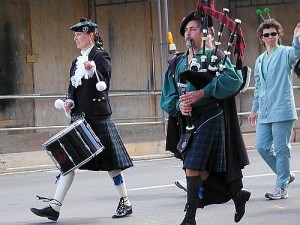With the big announcement about Google Plus combining with Google Places to create Local+, a new spotlight is on local SEO – a niche that can have a big impact on small businesses.
Local tactics focus on bringing your client or business in front of people who live and work close to your target community, but at heart they still hew to the general principles of Internet marketing: telling stories in a compelling way.
Telling your story is important, but telling the stories of your community is the best local SEO strategy you’re not using. When you’re establishing your website, determine what makes you unique within your industry as well as what’s special about your community that you can connect with.
A real-world tie to a geographic area or city creates a goldmine of link-building opportunities that are otherwise completely unattainable. Here are some ways to start telling your community’s stories.

Give clients the feeling that you’re right down the street from them.
Photos as local proof
Want to show your visitors and target clients that you’re a local in the community? Prove it by incorporating photography of local parks, restaurants and even other local businesses into your website and marketing. Be sure to target photos that make sense in context of your site and contribute to the relevance of the topic you’re targeting.
First, get buy-in from your client to be the “man on the street.” It helps to point out that this plan doesn’t require them to shell out the hundreds of dollars they would have spent on a high-end photographer. Just have them whip out their smartphone and walk around a popular downtown area or landmark.
If your client isn’t willing or able to do that, consider sponsoring a local photography contest on your Facebook page or blog or reaching out to local photographers to ask if you can feature their photos in exchange for attribution. Chances are good they’ll even mention your project on their own social media outlets!
Once you’ve got some local photos, go to work and make sure they have the biggest benefit for your visibility when added to your site. Rename each photo with a descriptive title. Don’t be shy here – add a thorough description of the photo and an html anchor text link, full http:// url link or partial domain name link when available, giving your site attribution for the photo.
Be sure you add geo-tags, too (many smartphones do this automatically). This is a set of lattitude and longitude codes that identify the location in which the photo was taken and can add additional relevance to your photo to your target market.
On your blog or site, add “alt tags” to the photo using terms that actually describe what’s in the picture.
Join the photo ecosystem
To make the most of photo search opportunities, create profiles for sites like Panaramio.com, Picasa, Flickr and of course Local+. Add your geo-tagged photos and take credit with an anchor text attribution link in the description when it’s allowed. You’ll be surprised when you see how this photo content ends up bringing unexpected organic links you didn’t even have to work for when photos are picked up and distributed by an automated system.
Take advantage of any community-building opportunities provided by the platform. You can generally join groups, organize your photos into sets and share your photo in various ways to additional exposure to site users. Make sure you understand the rules of the community so you don’t end up violating them and getting your hard work removed.
Make the most of video
Short videos focusing on local spots can be a compelling element of your site and also offer additional fuel for conversation via social media channels. The core principle is to find locales that are relevant to your community while also finding a strong tie back your business.
For example, a caterer or restaurant owner could do a short tour of a local farmers market. A graphics/design company could point out unique graphics and logos used by local businesses or highly visible signs around town. An architecture client could provide insight into landmark buildings around the city.
Visit a local attraction or niche store, talk to the owners and ask if you can take some video for your website. They’d be crazy to reject your offer, and will likely promote your content, too. Take a 10-second slow pan from left to right, or do a slow walk-in with the camera on and focus on what’s interesting about the location.
Once you’ve got your video, either use simple movie software or take those video clips to a site like Animoto.com or Flixtime.com to pump out a video. These sites and processes also give you the ability to add narration as well as text slides to give context to your video.
Youtube is the go-to site for uploading video, but don’t stop there. Other video platforms like Vimeo, Viddler or MetaCafe can be highly relevent depending on the topic of your video. Use TubeMogul or OneLoad to manage syndication of the video to dozens of smaller video platforms.
Start your description with a full http:// url of your site to receive inbound organic links as the video is shared through the online video ecosystem. For example, if you add “americantowns” in addition to your city and state then your video will show up on your local American Towns page.
Leverage local blogs
Local bloggers are already active in your community, so reach out and interact with them to build on their efforts. Create a spreadsheet and do some Googling for “your area +blog.” Then try a Google Blog Search. Add all the blogs you can find that share your geographic market.
Next, explore each site. See if any topics are closely related to your area or just generally of interest to you. If so, add to the conversation with a comment on particularly interesting posts, or reach out to share the blog or a post on Facebook or Twitter. For blogs that are a great fit, email to see if they run guest posts, or mention them on a blog post and let them know about it. They’ll likely at least look over your content and maybe even start a larger conversation with you, giving rise to social mentions and possible links.
Events that lead to links

You don’t have to wear a kilt, but events can be a big link-building advantage!
The smallest real-world event can be multiplied online, with the potential benefit of quality citations and inbound links on top of the word of mouth benefits. Lots of websites listen for local events and then post their own content based on that information.
If you’re already holding local events, make sure to list them on sites like Zvents.com, Eventful.com and AmericanTowns.com, which gather event listings and often syndicate information to local newspaper websites as well.
If you’re not, consider holding an event, even if it’s just an industry meetup at the coffee shop next to your office.
Seek out sponsorships

Photo By http://www.davidcostaphotography.com
Look for ways your business can become involved in the community – links and marketing opportunities often follow.
I’m a referee of a local Roller Derby team, The Prison City Derby Dames in Chino Hills, Calif. They’re always more than happy to take sponsors and give them website banners, links, and mentions during their bi-monthly bouts. There are also dozens of start-up soccer, softball, and other sports teams that offer the same opportunities and would appreciate your contributions.
Look up your local league, give them some much-needed support in exchange for links from their club website, social mentions on their Facebook page and word-of-mouth reach to a receptive audience. City and county websites often have a list of local sports teams and their websites.
The key to all of these tactics is to move from detached online link building to community building in the real world. These efforts reach beyond just getting a good link back to your website. They help you to be a good citizen of your community and the Internet at the same time.




and get Google Business Photos/Virtual Tours
Local+ is such a best service same like the street view with google navigation. This is truly a great work done by google and this service also helpful for the local SEO to market their brands locally and here you write “telling the stories of your community is the best local SEO strategy you’re not using” is such a great idea for the development of local SEO. Photo ecosystem is also best suitable for this and an awesome piece of writing it is.